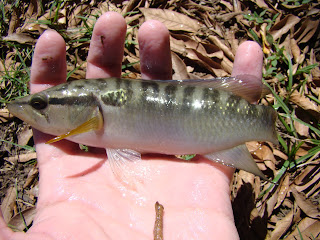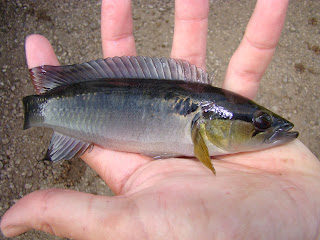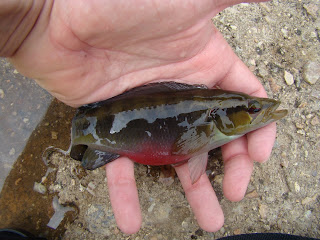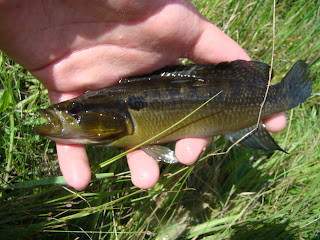The following is a brief photolog of the eight pike cichlids (Crenicichla) found in Uruguay. The species are organized into their respective species-groups (per Kullander et al. 2010).
Southern Species Group
Crenicichla vittata: potentially the largest species of pike cichlid, they are endemic to the Rio Uruguay drainage. They are typically restricted to the Rio Uruguay but can be found in the lower portions of large tributaries.

Crenicichla scottii: Found in both the Rio Uruguay drainage and in the southern coastal drainages of Uruguay. 

Crenicichla punctata: Found in eastern coastal drainages of Uruguay (and southern Brasil). Their distribution along the coast does not overlap with C. scottii.


saxatilis-Species Group
Crenicichla cf.
lepidota: Found in the Rio Uruguay drainage (main river and tributaries). The relationship to true C. lepidota from Bolivia is uncertain.

Crenicichla cf.
saxatilis: Found in the coastal drainages (southern and eastern) of Uruguay. The relationship to true C. saxatilis from Suriname is uncertain. 


If interested, you can read a photo journal about the
saxatilis-species group of Uruguay and see photographs of several different populations
here.
missioneira-Species Group
This species-group is endemic to the Rio Uruguay drainage and closely related.
Crenicichla missioneira 
Crenicichla minuano 
C. missioneira (Left) and
C. minuano (Right) are superficially similar, however they can be readily distinguished based on snout length and lower jaw protrusion.

Crenicichla tendybaguassu 
 C. tendybaguassu
C. tendybaguassu is also superficially similar in coloration and pattern to
C. missioneira and
C. minuano, however they can be distinguished by the well-developed lips.
Crenicichla celidochilus: Only found in middle and upper portions of tributaries to the middle and upper Rio Uruguay (in Uruguay and Brasil). 

If interested, you can read a short write-up about
C. celidochilus here.
E.D.B.












 If interested, you can read a photo journal about the saxatilis-species group of Uruguay and see photographs of several different populations here.
If interested, you can read a photo journal about the saxatilis-species group of Uruguay and see photographs of several different populations here.
 C. tendybaguassu is also superficially similar in coloration and pattern to C. missioneira and C. minuano, however they can be distinguished by the well-developed lips.
C. tendybaguassu is also superficially similar in coloration and pattern to C. missioneira and C. minuano, however they can be distinguished by the well-developed lips.
 If interested, you can read a short write-up about C. celidochilus here.
If interested, you can read a short write-up about C. celidochilus here.